Today, keeping a healthy balance of blood sugar is tough. But, the low glycemic diet is a great way to tackle this issue. It’s all about eating foods that don’t cause a quick spike in blood sugar. This method is known as the glycemic index (GI).
This diet is popular for helping with weight control, making insulin work better, and lowering the risk of chronic diseases. By eating foods that digest slowly, blood sugar levels go up more slowly. This can help prevent type 2 diabetes and its complications.
This guide will give you all you need to know about the low glycemic diet. It’s your step-by-step guide to better blood sugar control.
Key Takeaways : Low Glycemic Diet
- The low glycemic diet is based on the concept of the glycemic index, which measures how quickly a food raises blood sugar levels.
- Consuming low-GI foods can help regulate blood sugar, promote weight loss, and reduce the risk of chronic health conditions.
- Understanding the factors that affect the glycemic index of foods, such as type of sugar, starch structure, and processing, is crucial for following the low glycemic diet effectively.
- The low glycemic diet has been shown to provide benefits beyond blood sugar management, including improved cholesterol levels and potential cancer risk reduction.
- Incorporating a variety of low-GI foods, such as whole grains, fruits, vegetables, and lean proteins, is key to a successful low glycemic diet.
What is the Glycemic Index (GI)?
The glycemic index (GI) measures how foods affect blood sugar levels. It was created in the early 1980s by Dr. David Jenkins, a Canadian professor. The GI compares the absorption of 50 grams of carbs in a food to 50 grams of pure glucose, which has a GI of 100.
Carbohydrates and Blood Sugar
Carbs are key in a healthy diet, found in many foods like bread, cereals, fruits, veggies, and dairy. When you eat carbs, your body breaks them down into simple sugars. These sugars then enter your bloodstream. The GI shows how fast these sugars get absorbed and affect your blood sugar.
Understanding GI Numbers
Foods with a low GI (55 or less) digest slowly, causing a gradual rise in blood sugar. Foods with a high GI (70 or higher) digest fast, leading to a quick spike and drop in blood sugar. Medium GI foods have a value between 56 and 69.
“The glycemic index is a useful tool for managing blood sugar levels and making healthier food choices.”
Knowing the GI of foods helps you make better diet choices. This way, you can manage your blood sugar levels better.
Factors Affecting the Glycemic Index of Foods
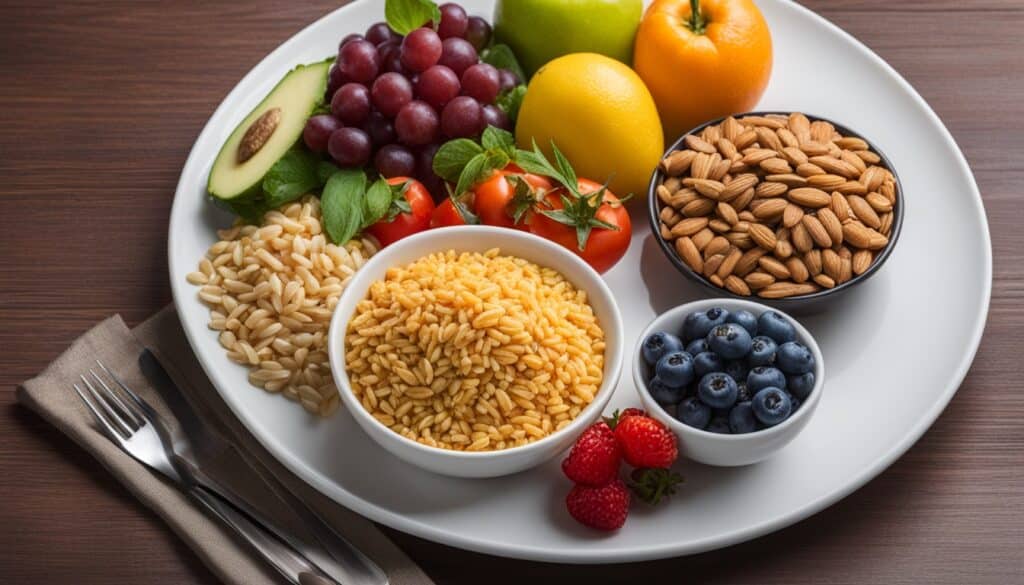
The glycemic index (GI) of a food changes because of many factors. Knowing these factors helps with a low-glycemic diet.
Type of Sugar
Many think all sugars have a high GI, but not true. The GI of sugar varies from 23 for fructose to 105 for maltose. The sugar type in a food greatly affects its GI.
Starch Structure
Starch is made of amylose and amylopectin. Foods with more amylose have a lower GI. Amylose is harder to digest than amylopectin.
Processing and Refining
How a food is processed affects its GI. Processing, like grinding, can raise a food’s GI. This happens because processing changes the starch’s structure, making it easier to digest.
Knowing these factors helps people on a low-glycemic diet. They can make better choices and control their blood sugar.
Low Glycemic Diet and Diabetes
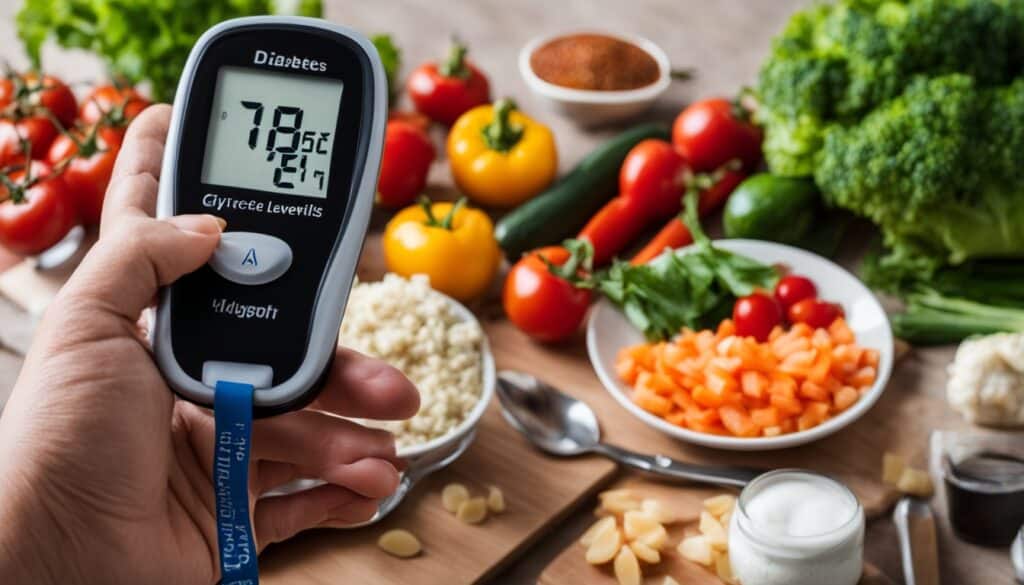
Diabetes affects millions of people worldwide. It makes it hard for those with diabetes to control their blood sugar levels. Keeping blood sugar in check is key to avoiding serious health issues like heart disease and nerve damage.
Research shows that eating low GI foods can help lower blood sugar in people with diabetes. High GI diets are linked to a higher risk of type 2 diabetes. Choosing low-GI foods helps manage blood sugar and lowers the risk of diabetes complications.
| Benefits of a Low GI Diet for Diabetes | Potential Risks of a High GI Diet |
|---|---|
| Improved blood sugar regulation | Increased risk of type 2 diabetes |
| Reduced risk of diabetes complications | Difficulty managing blood sugar levels |
| Potential weight management support | Increased risk of heart disease and stroke |
By choosing low-GI foods, people with diabetes can better manage their condition. This can lead to better health and lower the risk of long-term complications.
Other Benefits of a Low Glycemic Diet
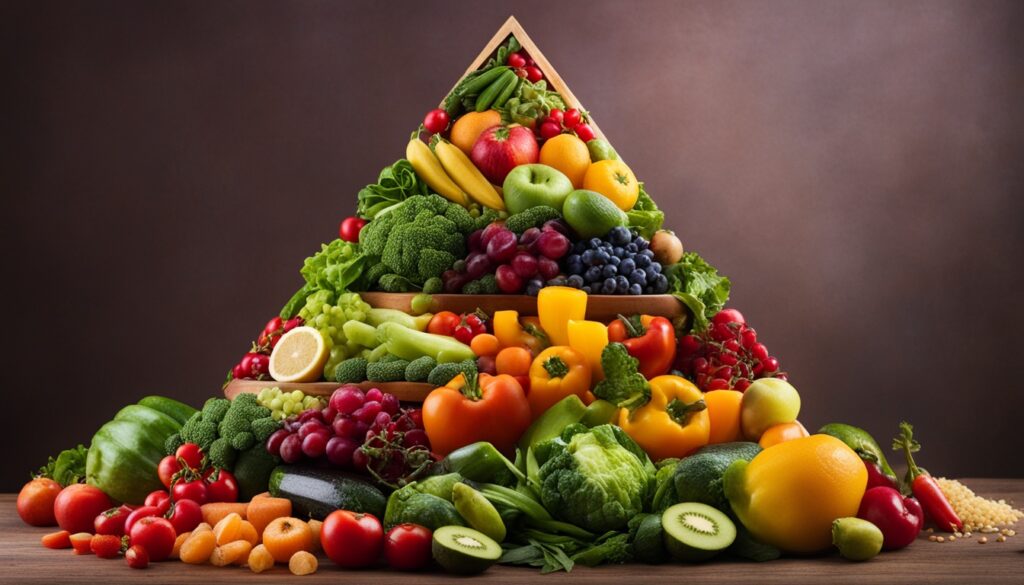
Following a low glycemic (GI) diet helps manage blood sugar levels. But, it also has more health benefits. These benefits make it a good choice for many people.
Improved Cholesterol Levels
Low GI diets can help with cholesterol. Studies show they lower total cholesterol by 9.6% and LDL (bad) cholesterol by 8.6%. This is good for the heart and lowers the risk of heart disease and stroke.
Potential Weight Loss
Some research points to low GI diets aiding in fat loss. But, we need more studies to be sure. Low GI foods keep blood sugar stable, which can help control hunger and aid in losing weight.
Reduced Cancer Risk
Studies link high GI diets to a higher risk of some cancers like endometrial, colorectal, and breast cancer. On the other hand, low GI diets might lower this risk. Scientists are still looking into how this works.
“Adopting a low glycemic diet may offer a multitude of health benefits beyond just managing blood sugar levels. From improved cholesterol to possible weight loss and reduced cancer risk, the advantages of this dietary approach are becoming increasingly clear.”
Foods to Eat on the Low Glycemic Diet
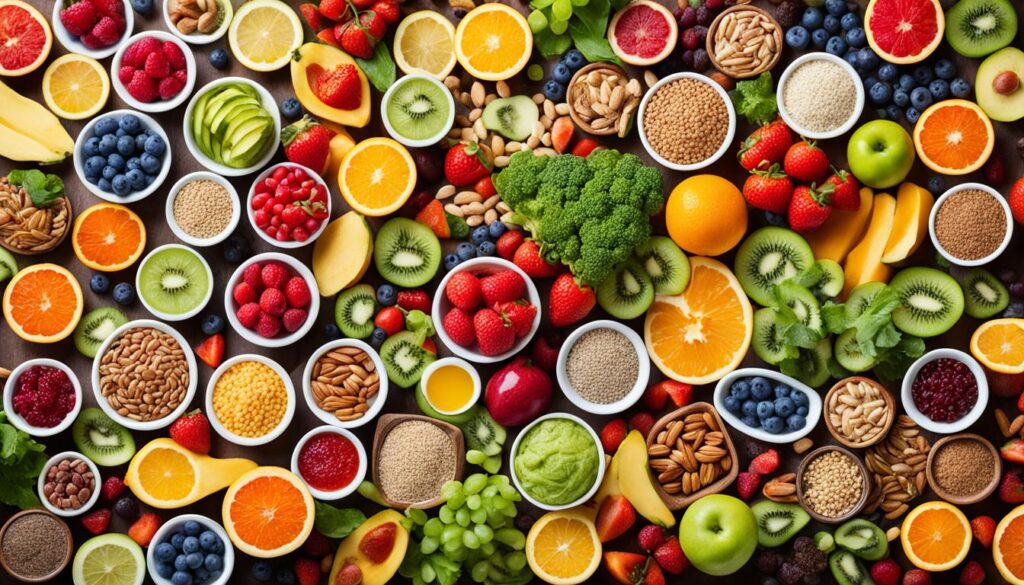
The low glycemic diet is about choosing foods with a low GI instead of high GI ones. This helps manage your blood sugar levels and brings health benefits. But what foods should you eat on this diet?
Whole grains are key on the low GI diet. Choose low GI carbs like whole wheat bread, steel-cut oats, quinoa, and barley. These carbs are digested slowly, giving you steady energy and avoiding blood sugar spikes.
- Whole wheat bread
- Steel-cut oats
- Quinoa
- Barley
Fruits and low GI vegetables are great for the low GI diet too. Good choices include berries, apples, citrus fruits, broccoli, spinach, and asparagus. These foods are full of fiber, vitamins, and minerals. They also don’t raise your blood sugar much.
- Berries
- Apples
- Citrus fruits
- Broccoli
- Spinach
- Asparagus
Legumes like beans, lentils, and chickpeas are also good on the low GI diet. They’re full of fiber, protein, and complex carbs. This makes them a great choice for managing blood sugar.
| Low GI Diet Food List | GI Value |
|---|---|
| Whole wheat bread | 51 |
| Steel-cut oats | 55 |
| Quinoa | 53 |
| Blueberries | 40 |
| Lentils | 29 |
By eating these low GI foods, you can make a diet that’s good for your blood sugar and overall health.
Foods to Avoid on the Low Glycemic Diet

The low glycemic (GI) diet focuses on choosing low GI foods over high GI ones. It’s not about cutting out foods completely, but about limiting high GI foods. This helps keep blood sugar stable and gets the most out of this diet.
White rice is a high GI food to cut down on. It has a GI score of 73, leading to a quick rise in blood sugar. Instead, go for low GI options like brown rice or quinoa. These foods affect glucose levels more slowly.
White bread, with a GI of 75, should also be eaten less. Try whole-grain, low GI breads like pumpernickel or sourdough instead. And don’t overdo it with white or russet potatoes, as they have a high GI too.
| High GI Foods to Avoid | GI Score |
|---|---|
| White Rice | 73 |
| White Bread | 75 |
| Potatoes (white or russet) | 78-85 |
By choosing low GI foods over high GI ones, you can better manage your blood sugar. This way, you can enjoy the many benefits of a low glycemic diet.
The Low Glycemic Diet
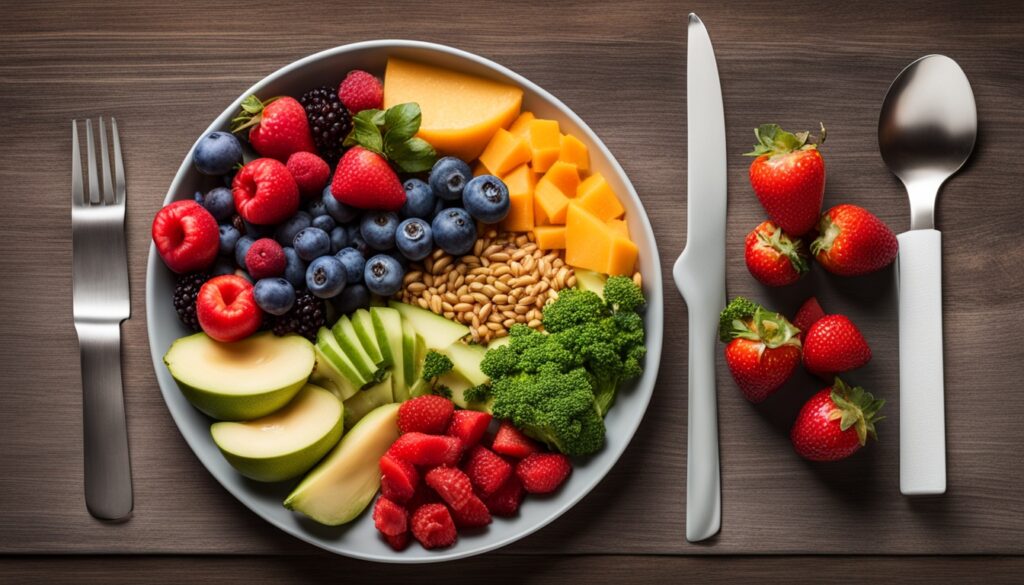
The low glycemic diet, also known as the low GI diet, focuses on choosing foods by their glycemic index (GI). The GI shows how fast a food raises blood sugar levels. This diet helps manage blood sugar, aids in weight loss, and may lower the risk of chronic diseases.
This diet is all about picking carbs that digest slowly. This leads to a steady rise in blood sugar. Unlike high GI foods, which cause a quick spike in blood sugar.
- Low GI foods include whole grains, legumes, most fruits and vegetables, and some dairy products.
- High GI foods include refined carbohydrates, such as white bread, white rice, and sugary snacks and drinks.
Following a low GI diet overview brings many benefits:
- Improved blood sugar control: Slow glucose release from low GI foods keeps blood sugar steady. This is great for people with diabetes or prediabetes.
- Enhanced weight management: Low GI foods make you feel full, helping with weight loss by reducing overeating.
- Reduced risk of chronic diseases: Eating low GI foods often lowers the risk of heart disease, some cancers, and polycystic ovary syndrome (PCOS).
To follow the low GI diet, eat a lot of whole, minimally processed carbs. Choose low GI options to enjoy the diet’s benefits.
| Low GI Foods | High GI Foods |
|---|---|
| Oats, quinoa, barley, whole wheat bread | White bread, white rice, potatoes, refined cereals |
| Lentils, chickpeas, black beans | Crackers, pretzels, chips |
| Most fruits, vegetables, and dairy products | Sweets, soda, and other sugary treats |
Adding low GI foods to your diet and cutting down on high GI ones is a smart move for your health.
Also Read : How Does Reproductive Health Affect Men And Women?
Conclusion
The low glycemic diet is a great way to manage blood sugar and improve health. It focuses on eating low GI carbs and avoiding high GI foods. This helps with better blood sugar control, weight management, and lowers the risk of chronic diseases like heart disease and some cancers.
This diet helps keep blood sugar stable, aids in weight loss, and may reduce health risks. It’s a strong tool for those looking to improve their metabolic health and overall well-being.
In short, the low glycemic diet offers a solid plan for managing blood sugar and gaining health benefits. By choosing wisely what carbs to eat, people can play a big part in their health and wellness journey.
FAQs
Q. What is the glycemic index (GI)?
The glycemic index (GI) measures how foods affect blood sugar levels. It was first developed in the 1980s by Dr. David Jenkins, a Canadian expert.
Q. How does the glycemic index work?
The GI compares how 50 grams of carbs in a food affect blood sugar to pure glucose. Foods with a low GI (55 or less) digest slowly, causing a gradual blood sugar increase. On the other hand, high GI foods (70 or more) digest fast, leading to a quick spike and drop in blood sugar.
Q. What factors affect the glycemic index of foods?
The GI can change based on the sugar type, starch structure, and processing level. Foods with more amylose and less processing tend to have a lower GI.
Q. How does the low glycemic diet affect diabetes?
A low GI diet can lower blood sugar in people with diabetes. It might also prevent or delay type 2 diabetes.
Q. What other health benefits does the low glycemic diet offer?
This diet can improve cholesterol levels, aid in weight loss, and lower the risk of some cancers. These include endometrial, colorectal, and breast cancer.
Q. What foods are allowed on the low glycemic diet?
Focus on whole, lightly processed carbs like whole grain bread, steel cut oats, most fruits and veggies, legumes, and grains such as quinoa and barley.
Q. What foods should be limited on the low glycemic diet?
Eat less of high GI foods like white rice, white bread, and potatoes.
Q. How do I follow the low glycemic diet?
Choose low GI foods that digest slowly, replacing high GI ones. This helps control blood sugar levels.
Source Links
- https://www.healthline.com/nutrition/low-glycemic-diet
- https://www.mayoclinic.org/healthy-lifestyle/nutrition-and-healthy-eating/in-depth/low-glycemic-index-diet/art-20048478
- https://www.ebay.com/itm/355804880311








Leave A Comment